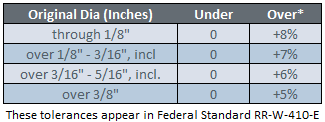Guide to Wire Rope
MENU
- Structural Wire Rope Applications
- Computer-Assisted Design and Detailing
- High Strength Structural Strand
- Custom Finishes
- Pre-stretching
- Striping
- Measuring Wire Rope
- Corrosion Protection
- End Terminations
- Attaching Sockets
- Proof loading
- Order Specifications
- Wire Rope Selection
- Rotation-Resistant Ropes
- Specialized Wire Rope
- Wire Rope Handling and Installation
- Standard Operating Practices
- Wire Rope Inspection
- Technical Info & Specifications
Tolerance & Wire Rope Strength Design Factors
Wire Rope Tolerances
Wire rope is always manufactured larger—never smaller—than the nominal diameter when specified in inches. The allowable tolerances are shown in the table.
In standard practice, the nominal diameter is the minimum diameter. All tolerances are taken on the plus side when specified in inches. Wire rope is not termed oversize until its diameter exceeds the allowable maximum. For example, a 1" nominal diameter wire rope may vary between 1" and 1.05" in diameter.
Diameter Tolerances

Rope Strength Design Factors
The rope strength design factor is the ratio of the rated strength of the rope to its operating stress. If a particular rope has a rated strength of 100,000 lbs. and is working under an operating stress of 20,000 lbs., it has a rope strength design factor of 5. It is operating at one-fifth or 20% of its rated strength.
Many codes refer to this factor as the "safety factor" which is a misleading term since this ratio obviously does not include many facets of an operation which must be considered in determining safety.
Wire rope is an expendable item—a replacement part of a machine or installation. For economic and other reasons, some installations require ropes to operate at high stresses (low rope strength design factors). On some installations where high risk is involved, high rope strength design factors must be maintained. However, operating and safety codes exist for most applications and these codes give specific factors for usage. When a machine is working and large dynamic loadings (shock loadings) are imparted to the rope, the rope strength design factor will be reduced, which may result in over stressing of the rope. Reduced rope strength design factors frequently result in reduced service life of wire rope.

